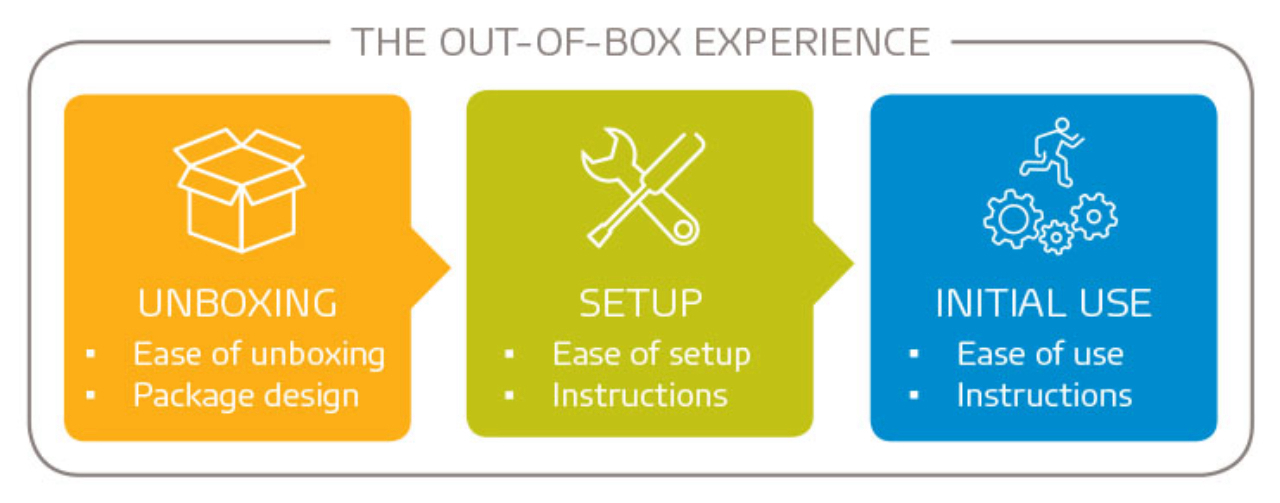Yes, the title of this post refers to your product. That isn’t to say your product isn’t selling. Indeed, customers are out there purchasing your product—but it’s not what they’re buying. What customers actually buy is the experience of using your product. Unless your product was designed for the sole purpose of sitting on a shelf, your customers will take your product home and use it. This experience of product use is what you’ve sold.
How well have you designed that experience? Neither the product life cycle, nor the customer journey, ends at purchase. On the contrary, it is at this point that things get very interesting. It’s time to examine the quality of the user experience (UX) you have provided for your customers; it’s time to think “out-of-the-box.” Literally.
The out-of-box experience
The out-of-box experience (depicted in the graphic below) is a critical touchpoint of the customer journey, covering the unboxing, product setup, and initial use of a product.
Creating a positive experience during unboxing involves attention to the package design, product look and feel, and the anticipation surrounding product use. What expectations do customers have as they unbox your product, and will those expectations be met or thwarted during product setup and initial use?
Product setup typically involves instructions for use (IFU) of some kind. These instructions not only guide the customer through the assembly, installation, or initialization process, but also prepare and guide the customer in the product’s initial use. This first experience is crucial toward fostering the desired attitudes and emotions indicative of product success.
Each aspect of the out-of-box experience should align with both product expectations and your brand. The good news is that you have a lot of control over how this experience occurs for your customers; you can see to it that the design for the out-of-box experience matches (or exceeds) your customers’ expectations.
Improve your product’s out-of-box experience
By optimizing the out-of-box experience for your customers, you are also more likely to:
- Decrease the number of product returns
- Reduce the number of calls into your call center (product support or complaints)
- Retain more customers
- Increase future purchases for other products under the same brand
- Influence product/brand reputation (social media reviews and word-of-mouth)
- Delight your customers!
With so much to gain, it makes sense to consider the out-of-box experience for your product. Is it up to your standards? How do you know? If you find it lacking, which aspects of it should you address to have the greatest impact?
UX research can uncover the answers to these questions. Testing can include in-lab or in-field research to observe users interacting with the packaging and product. An expert evaluation can also reveal pain points. It’s also possible to employ a survey tool, such as the UX Score, which can measure usability, usefulness, and aesthetics and determine the dimensions along which the out-of-box experience is the weakest and strongest, allowing you to focus strategically on the items most in need.
How well are you able to deliver on what your customers are buying? Attention toward the out-of-box experience can help generate excitement and delight around your product and your brand.
View our latest webinar recording, How to think “out of the box” about what your customers are actually buying. In this webinar, Flori Manning, PhD, User Experience Design Director for GfK, highlights what organizations stand to gain from optimizing this memorable experience, user experience best practices and how they are applied to product learnability, and the challenges and considerations for package design and instructions for use (IFU) design.
You can also download our latest white paper How to design great product instructions: Five challenges to overcome. In this paper, we detail these challenges and how to overcome them.
There are so many ways to connect with your customers with respect to instruction design that yield positive outcomes, including successful product use and how users perceive both product and brand. Read the whitepaper to see what techniques are appropriate for your product’s out-of-box experience.
For more information, contact Flori Manning, PhD at flori.manning@gfk.com





